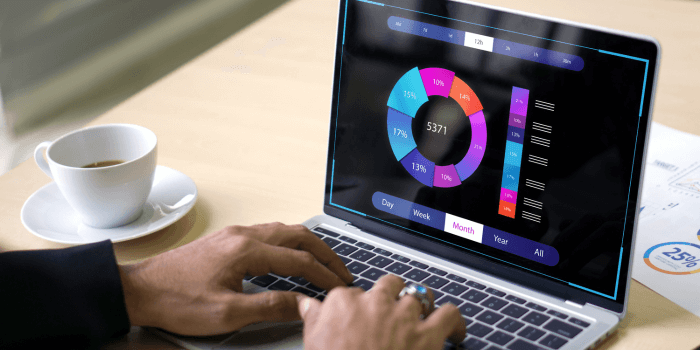LinkedIn is widely regarded as the quintessential platform for conducting business online.
Its unique combination of professional networking, recruitment capabilities, and business-oriented content sharing sets it apart from other platforms in the digital landscape.
What are Vanity Metrics?
While having a large number of followers on your LinkedIn company page may initially seem impressive, sheer quantity does not equate to meaningful impact or business success. Consider a scenario where you have amassed 10,000 followers, but only a minuscule fraction, say 2%, actively engage with your content. In this case, the vast majority of your followers remain passive spectators, contributing little to your brand's growth or bottom line.
These inactive followers represent what is commonly referred to as vanity metrics – numbers that may inflate your page's perceived popularity but hold little tangible value when it comes to achieving your business objectives. Vanity metrics may stroke the ego momentarily, but they fail to drive the genuine connections, lead generation, or conversions necessary for sustainable business growth.
Rather than fixating solely on increasing follower count, businesses should prioritize metrics that reflect the quality of engagement and interactions with their content. Metrics such as engagement rate, click-through rates, conversions, and the depth of interactions provide invaluable insights into how effectively your LinkedIn company page resonates with your target audience and contributes to your overarching business goals.
For instance, a high engagement rate indicates your content resonates with your audience, fosters meaningful discussions, and potentially attracts new leads or clients. Similarly, a high click-through rate suggests that your content is compelling enough to prompt users to take action, whether visiting your website, downloading resources, or exploring your products and services further.
Ultimately, the true measure of success on LinkedIn lies not in the sheer number of followers but in the quality of engagement and its impact on your business outcomes. These are revenue metrics directly tied to generating revenue or impacting your bottom line.
By focusing on fostering genuine connections, nurturing engagement, and delivering valuable content, businesses can leverage LinkedIn as a powerful tool for both brand building and business growth. After all, the ultimate goal of leveraging social media platforms like LinkedIn is not merely to bolster your brand's image but to drive tangible results and build a thriving, sustainable business.
Understanding LinkedIn's B2B Sales and Lead Generation Tools
So, where do you begin? LinkedIn has revolutionized how businesses approach sales and lead generation by providing powerful tools and features tailored specifically for B2B networking and outreach.
LinkedIn prospecting involves identifying and connecting with potential leads and prospects within your target market. Leveraging the platform's advanced search filters, you can narrow your search criteria based on factors such as industry, job title, company size, and geographic location to pinpoint individuals most likely to be interested in your products or services.
Once you've identified potential leads, social selling on LinkedIn will come into play. This strategy focuses on building genuine relationships and engaging with prospects through personalized messaging, content sharing, and meaningful interactions. By establishing yourself as a trusted authority within your industry and providing valuable insights and resources, you can position your company as a go-to solution provider for your target audience's needs.
LinkedIn's messaging features, such as InMail and personalized connection requests, allow you to initiate conversations with prospects in a professional and non-intrusive manner. LinkedIn's Sales Navigator tool provides advanced lead management capabilities, allowing you to track and prioritize leads, set reminders for follow-ups, and stay organized throughout the sales process. With features like Lead Recommendations and TeamLink, you can tap into your network's connections to uncover warm leads and leverage existing relationships to expand your reach and credibility.
The Crucial Role of Quality Content in Sustaining Growth
While generating leads and raising awareness through active engagement and outreach on LinkedIn can contribute significantly to the growth of your company page and follower base, sustaining that growth relies on the quality of the content you share. When you interact with followers and approach prospects, they're inclined to visit your company page for further insight into your business and to decide whether to do business with you.
Posting content simply for the safe of maintaining a presence is unlikely to produce desirable results. In today's digital landscape, where users are inundated with a constant stream of information, it's essential to cut through the noise with relevant, valuable, and engaging content.
Quality content is more than just frequency; it's about providing substance, insights, and solutions that resonate with your audience's interests and pain points. Whether it's thought-provoking articles, informative guides, or engaging visuals, every piece of content should add value and contribute to building your brand's credibility and authority within your industry.
Quality content also fosters genuine connections and encourages meaningful interactions with your audience. When followers and prospects visit your company page, they expect to find valuable insights, updates, and resources that enrich their understanding of your brand and its offerings. If your page lacks compelling content or appears stagnant, visitors may quickly lose interest and seek information elsewhere, potentially turning to competitors who actively engage and provide valuable content.
Recent changes to the LinkedIn algorithm underscore the increasing importance of posting quality content. LinkedIn is introducing a new feature called "suggested post," which revolutionizes how content appears in users' feeds. This innovative approach aims to showcase the best posts to targeted audiences over an extended period, potentially spanning months or even years. This initiative reflects LinkedIn's shift towards prioritizing knowledge and advice over virality, marking a significant departure from other social media algorithms.
While this project is still in its infancy, it promises substantial benefits for individuals and businesses that consistently publish high-quality content.
As explained by Entrepreneur:
"Let's say you went to LinkedIn and posted a detailed lesson about beverage marketing. Typically, that post would disappear from people's feeds within a few days or more. Now, LinkedIn is thinking differently. It might identify your post as uniquely useful - and whenever other users show an interest in beverage marketing, it might display your post in their feed as a special "suggested post." This means your content could actively live on for months or even years, reaching a hyper-targeted audience."
The Importance of Data-Driven Audience Building
This brings us to the next challenge facing businesses – what content should you post, and what defines quality content? A practical approach involves a thorough examination of your existing content. This is where we go back to the topic of vanity metrics and revenue metrics. What content of yours performs well, and what is it about? Maybe it’s an article on industry trends or an infographic about best practices in your field. Understanding the specific topics and formats that resonate with your audience can guide your content strategy and make sure you're delivering valuable and engaging content consistently.
Furthermore, it is crucial to gather insights about your audience. Being intentional about your audience involves delving into demographics, interests, and pain points relevant to your business niche. This knowledge means you can create content that speaks directly to your ideal audience, resonating with them on a deeper level.
Expanding on Andrew Gazdecki’s insights, identifying and nurturing a core group of loyal followers serves as the cornerstone for audience building. These individuals are passive observers and active participants who engage with your content, provide feedback, and amplify your brand's message within their networks.
To truly understand what works for your audience, explore your analytics, gather feedback, and actively listen to their needs and preferences. Moreover, leveraging tools like LinkedIn's audience insights allows you to gain deeper insights into the characteristics and behaviors of your audience, helping you refine your targeting and content strategy for optimal results.
In essence, audience building on LinkedIn is about developing meaningful connections with individuals who align with your brand values and objectives. By nurturing these relationships and delivering content that adds genuine value, you can lay a solid foundation for sustainable growth and success on the platform.
Ultimately, the goal is to strike a balance between creativity and data-driven decision-making. While creative experimentation is essential for innovation, data-driven insights offer guidance and validation for your content strategy. By leveraging qualitative and quantitative analysis of your current content, you can refine your approach, optimize engagement, and drive tangible business outcomes.
Ready to unlock the full potential of LinkedIn for your business growth? Schedule a complimentary 30-minute consultation with Rutkin Marketing today. Let's discuss how we can tailor strategies to elevate your online presence and achieve your business objectives.


